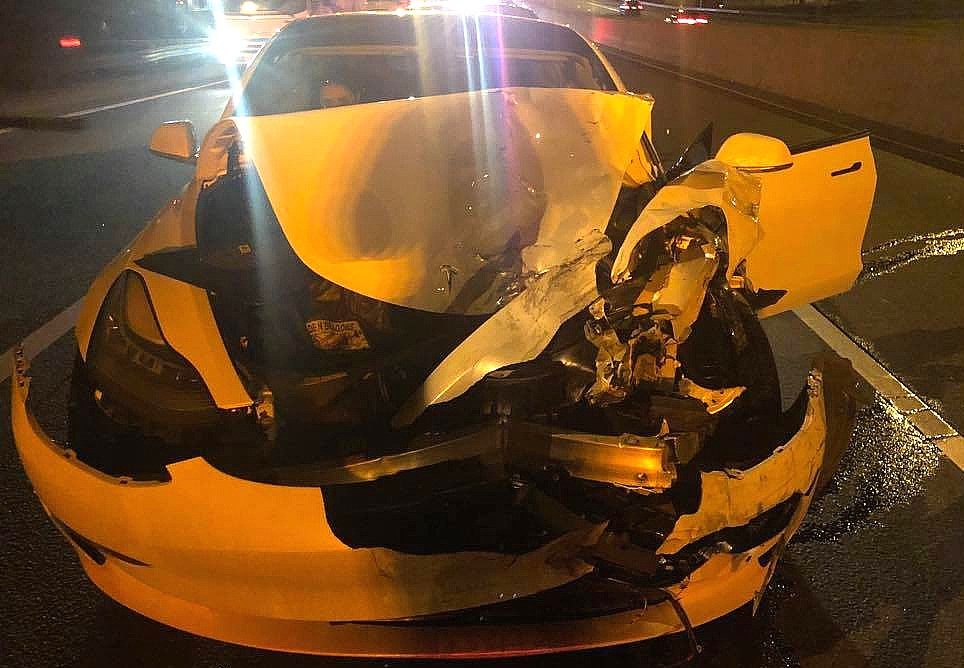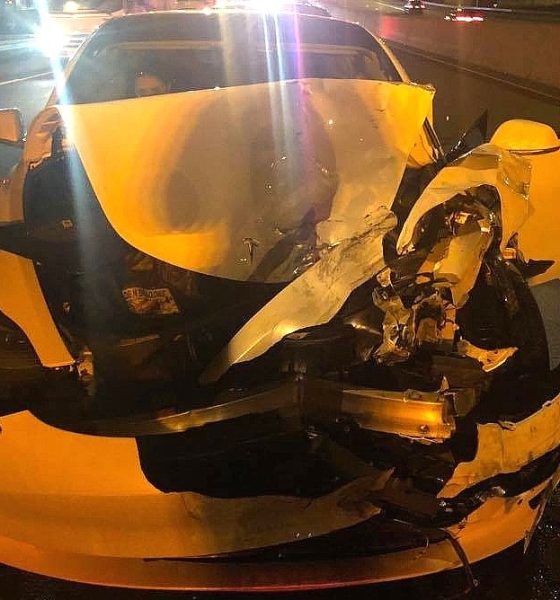

News
Tesla Autopilot under fire once more from US Senator following accident
A United States Senator who has been vocal about his opposition to Tesla’s Autopilot software is doubling down after a driver utilizing the driver-assist feature in his Model 3 rear-ended a police cruiser in Connecticut on the evening of December 7, 2019. Senator Ed Markey of Massachusetts has been vocal regarding his discontent for the alleged “flawed system” Tesla Autopilot offers to drivers. After The Today Show reported the recent accident on its Twitter account, Sen. Markey responded with his thoughts.
“Autopilot clearly can’t be allowed to replace drivers on our roads. This tech will continue causing harm until Tesla takes action to fix its flawed system and make sure drivers are paying attention. That’s why I sent a letter demanding Tesla take action to protect the public,” Markey wrote on Twitter.
According to police, the accident happened because the Model 3 driver was checking on his dog at the backseat. Thus, the Tesla driver was unable to use the driver-assist system in an appropriate manner.
In late November, Sen. Markey called for Autopilot to be disabled because of some drivers were falling asleep behind the wheel while the software was active. It should be noted that Tesla has never encouraged drivers to take their attention off of the road when utilizing Autopilot. The company has taken numerous steps to decrease the possibility of this happening by adding safety features to the software. Tesla’s official website emphasizes this point, reminds owners that “while using Autopilot, it is your responsibility to stay alert, keep your hands on the steering wheel at all times, and maintain control of your car.”
Tesla has added features to stop the vehicle from driving if it senses the person controlling the car is not paying attention to the road. If the person operating the vehicle does not hold the steering wheel for an extended period of time, Autopilot will disable itself. Autosteer will also be disabled for the remainder of the trip, forcing the driver to operate the vehicle normally.
Autopilot is responsible for Tesla’s reputation for being involved in accidents over six and a half times less often than a traditional vehicle. Teslas that are utilizing Autopilot features were involved in an accident every 2,870,000 mile,s according to the company’s Q1 report in 2019. This stands in contrast to the national average of one accident for every 436,000 miles traveled by traditional vehicles without Tesla’s Autopilot software.
Tesla has released updates and improvements to its Autopilot and Full Self-Driving software frequently. The company has been firm in the notion that it does not condone the practice of sleeping behind the wheel. Tesla also instructs drivers to always keep their full attention during driving to significantly reduce the possibility of an accident. Ultimately, Autopilot was not to blame in the case of the recent accident in Connecticut because the driver was admittedly checking on his pet in the back seat of the car. The police, for one, ticketed the Model 3 owner for Reckless Driving and Reckless Endangerment, according to the Connecticut State Police Facebook account.
Now if only Sen. Markey could see the incident from this perspective.

News
Tesla FSD fleet is nearing 7 billion total miles, including 2.5 billion city miles
As can be seen on Tesla’s official FSD webpage, vehicles equipped with the system have now navigated over 6.99 billion miles.

Tesla’s Full Self-Driving (Supervised) fleet is closing in on almost 7 billion total miles driven, as per data posted by the company on its official FSD webpage.
These figures hint at the massive scale of data fueling Tesla’s rapid FSD improvements, which have been quite notable as of late.
FSD mileage milestones
As can be seen on Tesla’s official FSD webpage, vehicles equipped with the system have now navigated over 6.99 billion miles. Tesla owner and avid FSD tester Whole Mars Catalog also shared a screenshot indicating that from the nearly 7 billion miles traveled by the FSD fleet, more than 2.5 billion miles were driven inside cities.
City miles are particularly valuable for complex urban scenarios like unprotected turns, pedestrian interactions, and traffic lights. This is also the difference-maker for FSD, as only complex solutions, such as Waymo’s self-driving taxis, operate similarly on inner-city streets. And even then, incidents such as the San Francisco blackouts have proven challenging for sensor-rich vehicles like Waymos.
Tesla’s data edge
Tesla has a number of advantages in the autonomous vehicle sector, one of which is the size of its fleet and the number of vehicles training FSD on real-world roads. Tesla’s nearly 7 billion FSD miles then allow the company to roll out updates that make its vehicles behave like they are being driven by experienced drivers, even if they are operating on their own.
So notable are Tesla’s improvements to FSD that NVIDIA Director of Robotics Jim Fan, after experiencing FSD v14, noted that the system is the first AI that passes what he described as a “Physical Turing Test.”
“Despite knowing exactly how robot learning works, I still find it magical watching the steering wheel turn by itself. First it feels surreal, next it becomes routine. Then, like the smartphone, taking it away actively hurts. This is how humanity gets rewired and glued to god-like technologies,” Fan wrote in a post on X.
News
Tesla starts showing how FSD will change lives in Europe
Local officials tested the system on narrow country roads and were impressed by FSD’s smooth, human-like driving, with some calling the service a game-changer for everyday life in areas that are far from urban centers.

Tesla has launched Europe’s first public shuttle service using Full Self-Driving (Supervised) in the rural Eifelkreis Bitburg-Prüm region of Germany, demonstrating how the technology can restore independence and mobility for people who struggle with limited transport options.
Local officials tested the system on narrow country roads and were impressed by FSD’s smooth, human-like driving, with some calling the service a game-changer for everyday life in areas that are far from urban centers.
Officials see real impact on rural residents
Arzfeld Mayor Johannes Kuhl and District Administrator Andreas Kruppert personally tested the Tesla shuttle service. This allowed them to see just how well FSD navigated winding lanes and rural roads confidently. Kruppert said, “Autonomous driving sounds like science fiction to many, but we simply see here that it works totally well in rural regions too.” Kuhl, for his part, also noted that FSD “feels like a very experienced driver.”
The pilot complements the area’s “Citizen Bus” program, which provides on-demand rides for elderly residents who can no longer drive themselves. Tesla Europe shared a video of a demonstration of the service, highlighting how FSD gives people their freedom back, even in places where public transport is not as prevalent.
What the Ministry for Economic Affairs and Transport says
Rhineland-Palatinate’s Minister Daniela Schmitt supported the project, praising the collaboration that made this “first of its kind in Europe” possible. As per the ministry, the rural rollout for the service shows FSD’s potential beyond major cities, and it delivers tangible benefits like grocery runs, doctor visits, and social connections for isolated residents.
“Reliable and flexible mobility is especially vital in rural areas. With the launch of a shuttle service using self-driving vehicles (FSD supervised) by Tesla in the Eifelkreis Bitburg-Prüm, an innovative pilot project is now getting underway that complements local community bus services. It is the first project of its kind in Europe.
“The result is a real gain for rural mobility: greater accessibility, more flexibility and tangible benefits for everyday life. A strong signal for innovation, cooperation and future-oriented mobility beyond urban centers,” the ministry wrote in a LinkedIn post.
News
Tesla China quietly posts Robotaxi-related job listing
Tesla China is currently seeking a Low Voltage Electrical Engineer to work on circuit board design for the company’s autonomous vehicles.

Tesla has posted a new job listing in Shanghai explicitly tied to its Robotaxi program, fueling speculation that the company is preparing to launch its dedicated autonomous ride-hailing service in China.
As noted in the listing, Tesla China is currently seeking a Low Voltage Electrical Engineer to work on circuit board design for the company’s autonomous vehicles.
Robotaxi-specific role
The listing, which was shared on social media platform X by industry watcher @tslaming, suggested that Tesla China is looking to fill the role urgently. The job listing itself specifically mentions that the person hired for the role will be working on the Low Voltage Hardware team, which would design the circuit boards that would serve as the nervous system of the Robotaxi.
Key tasks for the role, as indicated in the job listing, include collaboration with PCB layout, firmware, mechanical, program management, and validation teams, among other responsibilities. The role is based in Shanghai.
China Robotaxi launch
China represents a massive potential market for robotaxis, with its dense urban centers and supportive policies in select cities. Tesla has limited permission to roll out FSD in the country, though despite this, its vehicles have been hailed as among the best in the market when it comes to autonomous features. So far, at least, it appears that China supports Tesla’s FSD and Robotaxi rollout.
This was hinted at in November, when Tesla brought the Cybercab to the 8th China International Import Expo (CIIE) in Shanghai, marking the first time that the autonomous two-seater was brought to the Asia-Pacific region. The vehicle, despite not having a release date in China, received a significant amount of interest among the event’s attendees.








